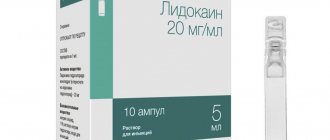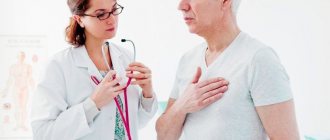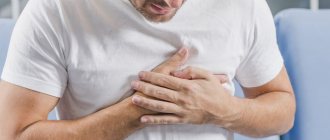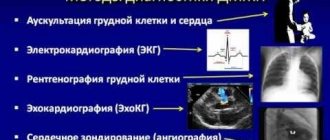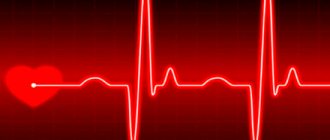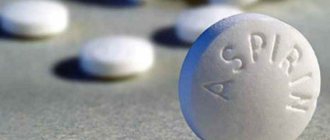Heart rhythm disturbances are a group of cardiovascular diseases that doctors call the most common. Therefore, today we will talk about the factors that provoke such heart problems and ways to combat them. We will also get acquainted with the main treatment methods.
Why is the heart rhythm disrupted?
The normal heart rate is between 70-80 beats per minute at rest. It can increase with physical activity, various emotional experiences, exposure to medications, and alcohol.
A slowdown in heart rate is observed with general weakness, severe fatigue, in old age, in athletes or during sleep. In addition, various types of disorders can be caused by side effects of medications or diseases of internal organs (for example, pathologies of the nervous system).
Also, arrhythmias can occur due to cardiovascular diseases, among which the main role is played by:
- myocardial damage caused by atherosclerosis of the coronary arteries, inflammatory processes, injuries and other factors;
- lesions of the sinus node in the heart caused by congenital or acquired factors;
- tumors of the heart muscle;
- pericardial lesions. We are talking about pericarditis, adhesions, metastases and other problems;
- disturbed balance of electrolytes (deficiency of Mg, K, Ca and Na);
- catheterization, angiography, surgical interventions that irritate the heart.
In addition, the problem in question can also occur in completely healthy people. For example, the loss of one or more beats - in other words, extrasystole - happens to any person from time to time.
Such cardiac failures do not cause inconvenience and are not accompanied by a risk to life and health, unless they become permanent.
Causes of cardiac arrhythmia
In practically healthy people, arrhythmia can occur due to overheating, being in a stuffy room, overeating, and also as a result of taking certain medications.
There is a high risk of this disease in patients suffering from diabetes, hypertension, and obesity. In women, arrhythmia is often detected during menopause and pregnancy, which is a temporary condition.
Much more serious causes are heart diseases: myocarditis, coronary disease, heart defects, myocardial infarction, malignant neoplasms. In these cases, arrhythmia is an indicator to which the doctor must pay close attention in order to prescribe the correct timely treatment.
What is arrhythmia?
There are several types of the problem, each of which has its own characteristics and symptoms. Tachycardia is an increase in the number of heart contractions over 90 beats per minute. It can occur in various parts of the heart, therefore it is divided into ventricular and supraventricular.
Bradycardia is a decrease in heart rate below 60 beats. Pathology can occur with heart blockades, as well as weakness of the sinus node. Paroxysmal rhythm disturbance is a problem manifested by a sharp increase in heart rate up to 200 beats. At the same time, the person is outwardly healthy. A person’s condition at this moment can vary from mild weakness and general malaise to loss of consciousness. In most cases, the attack goes away on its own within a few minutes, but with severe paroxysms, emergency medical attention is required.
Extrasystole is a condition in which the normal rhythm of the heart is interrupted by a single premature contraction of the myocardium. Subjectively, it feels like a short interruption of the heart. Each person experiences an average of one and a half thousand extrasystoles per day. If they do not cause discomfort, treatment is not required.
Atrial fibrillation - with this disease, one of the phases of the normal heart rhythm disappears: atrial contraction. As a result, instead of a full contraction, the muscle fibers only twitch - flicker. Because of this, the functioning of the ventricles of the heart is disrupted: they begin to contract irregularly. In severe cases, atrial fibrillation can develop into atrial fibrillation, a condition that threatens a person’s life and requires immediate medical attention. Any disturbances in heart rhythm should not be ignored; if they appear, you should visit a cardiologist as soon as possible.
These include:
1. Rhythm control/pulse rate control
If rhythm disturbances occur more than once or twice a year, constant use of antiarrhythmic drugs is necessary.
Tactics to actively restore and maintain normal (sinus) rhythm using AAP are called rhythm control tactics. It is preferable in those patients with paroxysmal, permanent and persistent forms of the disease who lead an active lifestyle and do not have solid concomitant pathology. With fairly frequent, prolonged episodes of AF, ongoing planned antiarrhythmic therapy is also mandatory. Often, an increase in paroxysms is a natural course of the disease. But in some cases, this form of MA is caused by improper treatment, when the patient takes medications in insufficient doses or is not treated at all. It is the arrhythmologist who is called upon to select the treatment regimen that will help the patient cope with the disease. If it is unsuccessful, the patient may be recommended to consult a cardiac surgeon - arrhythmologist for surgical treatment of AF.
If this arrhythmia becomes permanent, active rhythm restoration is not indicated due to ineffectiveness. Under the influence of a long-term arrhythmia, the structure and function of the heart change and it “gets used” to living with it; it is no longer possible. In such patients, pulse control tactics are used, that is, with the help of medications, a heart rate that is comfortable for the patient is achieved. But no active attempts are made to restore the rhythm.
The following are currently used as antiarrhythmic drugs:
- beta blockers (metoprolol, bisoprolol, carvedilol)
- propafenone
- amiodarone
- sotahexal
- allapinin
- digoxin
- drug combination
2.Prevention of complications:
prevention of stroke and thromboembolism
With AF, there is no single, coordinated ejection of blood from the heart; some of the blood stagnates in its chambers and, in the form of blood clots, can enter the vessels. Most often, the blood vessels of the brain are affected and a stroke develops.
In order to prevent it, drugs that affect blood clotting are prescribed - warfarin, rivaroxaban, dabigatran, apixaban, which reliably (more than 90%) protect against stroke.
While taking these drugs, the patient should monitor for bleeding and monitor the complete blood count and creatinine quarterly. (when taking rivaroxaban, dabigatran and apixaban)., or test the INR (international normalized ratio) at least once a month when taking warfarin. This is necessary in order to correctly calculate the dose of the drug and monitor its safety.
Acetylsalicylic acid (aspirin, cardiomagnyl, thromboass) is not routinely used for the prevention of thromboembolism, since the degree of protection against venous thrombosis when used is only 25%.
prevention of heart failure
Heart failure (HF)
– a complication of many heart diseases, including AF. This condition is caused by the lack of full pumping function of the heart, as a result of which the liquid part of the blood stagnates in the tissues and organs, which is manifested by shortness of breath and edema.
For the prevention and treatment of heart failure, ACE inhibitors (enalapril, lisinopril, perindopril, etc.), veroshpiron (eplerenone), and diuretics (torasemide, furosemide, hypothiazide) are used.
3. Surgical treatment is used if there is no effect from medications and is carried out in specialized cardiac surgery clinics.
Types of surgical treatment of MA:
- implantation of a pacemaker for bradyform MA
- radiofrequency ablation of the pulmonary veins and other arrhythmogenic areas
- with paroxysmal tachyform of atrial fibrillation and flutter
Surgery for arrhythmias in general and AF in particular is the “last cartridge” used when drug therapy is unsuccessful.
After surgical treatment, in order to prevent recurrence of arrhythmia, patients are prescribed planned antiarrhythmic therapy.
Thus, treatment of atrial fibrillation is a way of life that involves the patient “working on himself.” And an arrhythmologist helps him with this.
A patient with MA should avoid colds, lead a healthy lifestyle, get rid of bad habits and avoid factors leading to its development, and strictly follow all the recommendations of his doctor. The doctor will help you choose an individual treatment regimen and recommend what to do if a recurrence of arrhythmia develops, and will also promptly refer you to a cardiac surgeon - arrhythmologist, if indicated.
It is important to understand that the selection of antiarrhythmic therapy takes some time, requires repeated examinations by a doctor and a number of dynamic studies (general clinical tests, study of thyroid hormone levels, cardiac ultrasound and Holter ECG monitoring, electrocardiogram registration) and this should be treated with understanding. In some cases, it is necessary to replace one drug with another.
Living with atrial fibrillation is not an easy process and it is very important that the patient feels supported and helped by the doctor. We are happy to help you with this and are ready to offer follow-up programs for a cardiologist, arrhythmologist and cardiac surgeon in our clinic.
How do arrhythmias manifest?
Different types of arrhythmias have their own manifestations. Only extrasystoles can be asymptomatic. With tachycardia, a person complains of rapid heartbeat, discomfort or chest pain, dizziness, sudden general weakness and fatigue, and shortness of breath. Also, with this pathology, blood pressure often decreases, which can cause a person to faint.
Some of these symptoms can also manifest themselves with bradycardia, in particular: dizziness, weakness, chest pain, fainting and fainting conditions. Also, with a decrease in the number of heart contractions, difficulty breathing, short-term visual disturbances, deterioration in concentration and memory, and episodes of confused thinking are observed. They arise due to the fact that the brain experiences oxygen starvation as a result of bradycardia.
The main sign of paroxysmal rhythm disturbance is a sharp deterioration in the condition. The duration of the attack is from two to three minutes to several days. During a paroxysm, a person feels a frequent and strong heartbeat, complains of general weakness, dizziness, tinnitus, sweating, nausea and flatulence.
Atrial fibrillation is accompanied by unreasonable fear (panic attack), and is also manifested by irregular heartbeat, intense sweating, shortness of breath, and severe general weakness. He even reaches the point of fainting. Different arrhythmias are similar in their symptoms. Therefore, making an accurate diagnosis is only possible in a medical institution.
Symptoms
When the heart beats faster than normal, it is called tachycardia . Symptoms and signs of arrhythmia include:
- chest discomfort
- cardiopalmus,
- dizziness,
- sometimes fainting.
When the heart beats slower than normal, it is called bradycardia . It can cause fatigue, dizziness, lightheadedness and fainting as it usually causes low blood pressure.
Almost everyone's heart will flutter from time to time, and it usually doesn't mean anything. More often, symptoms of cardiac arrhythmia occur in men and treatment is not always necessary. But if a person has chest pain, feels weak, or notices that the pulse is irregular, either very fast or very slow for a long period, it is time to see a doctor. Source: Insider's View Focus on the Arrhythmia Patient. Boqueria O.L. Annals of Arrhythmology, 2014. p. 196-199.
Symptoms of this disease may not appear. Arrhythmia can be detected by a specialist during a routine clinical examination: before any of its signs appear. But predominantly, heart rhythm disturbances are characterized by the following symptoms:
- pain in the chest;
- increased feeling of heartbeat;
- accelerated heartbeat;
- slow heartbeat;
- dyspnea;
- loss of consciousness or fainting.
In most cases, in a person who has a certain type of arrhythmia, such arrhythmia occurs repeatedly.
Some types of arrhythmias are initially asymptomatic or with few symptoms. Other types of arrhythmias, on the contrary, manifest themselves in pronounced symptoms, but do not have serious consequences. Typically, the nature and severity of the underlying heart disease that causes the arrhythmia are more important than the arrhythmia itself.
Diagnosis of arrhythmias
Diagnostic techniques: general (history collection, examination) and specific (non-invasive and invasive) techniques. Non-invasive research methods include:
- ECG;
- ergometry (physical stress tests);
- surface ECG mapping;
- echocardiography;
- magnetic resonance imaging.
Invasive diagnostics is an electrophysiological study in which special sensors are inserted into the heart cavity, which record the frequency and regularity of contractions of different parts of the myocardium.
First aid for an arrhythmia attack
Defibrillators are devices that restart blocked heart muscles by delivering electricity to the chest. Defibrillators are effective in stopping the heart from ventricular fibrillation, but because ventricular fibrillation can be fatal in less than 4 minutes, they should be used as soon as possible. Most defibrillators are external devices, but there are now automated implantable cardioverter/defibrillators (AICDs). These devices can be as large as pacemakers. They can detect dangerous fibrillation and return the heart to normal before any damage is done.
Article sources:
- "New Theory of Arrhythmia" clarifies the causes of arrhythmia. Ermoshkin V.I. Educational bulletin “Consciousness”, 2015. p. 22-30
- Innovations in the treatment of cardiac arrhythmia. Zh.A. Arzykulov, A.A. Omarov, B.B. Kituev, F.A. Tursunova, A.A. Yeshtay, N.G. Pavlova. Bulletin of Surgery of Kazakhstan, 2012. p. 4-5
- On the issue of classification of cardiac arrhythmias. Batyanov I.S., Batyanova E.I. Cardiovascular therapy and prevention, 2005
- A look from the inside focuses on a patient with arrhythmia. Boqueria O.L. Annals of Arrhythmology, 2014. p. 196-199
- Cardiac arrhythmias from the point of view of their dimension. Ubiennykh A.G. Measurement. Monitoring. Control. Control, 2021. p. 70-76
- Epidemiology of arrhythmias (review of literature data). Zatonskaya E.V., Matyushin G.V., Gogolashvili N.G., Novgorodtseva N.N. Siberian Medical Review, 2021. p. 5-16


